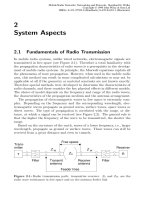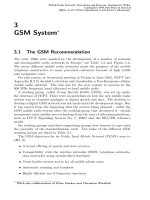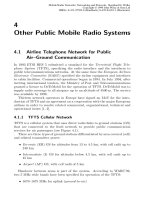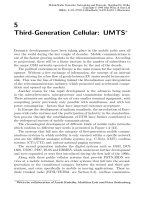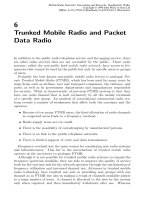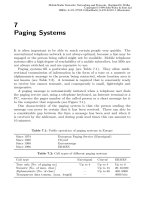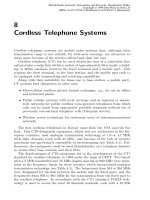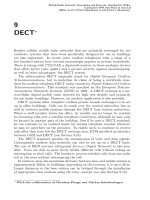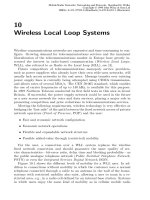Tài liệu Điện thoại di động mạng lưới Radio P6 ppt
Bạn đang xem bản rút gọn của tài liệu. Xem và tải ngay bản đầy đủ của tài liệu tại đây (899.16 KB, 74 trang )
6
Trunked Mobile Radio and Packet
Data Radio
In addition to the public radio telephone service and the paging service, there
are other radio services that are not accessible by the public. These radio
systems, called the non-public land mobile radio network , have access to fre-
quencies that cannot be used by the public but only by specific users or groups
of users.
Probably the best known non-public mobile radio service is analogue Pri-
vate Trunked Mobile Radio (PTMR), which has been used for many years by
large firms such as airlines, taxi and transport companies, the railways, and
ports, as well as by government departments and organizations responsible
for security. What is characteristic of previous PTMR systems is that they
have one radio channel that is used exclusively by all the mobile terminals
of a specific user group. An analysis of conventional commercial radio sys-
tems reveals a number of weaknesses that affect both the customer and the
operator:
• Because of too many PTMR users, the fixed allocation of radio channels
in congested areas leads to a frequency overload.
• Radio supply areas are too small.
• There is the possibility of eavesdropping by unauthorized persons.
• There is no link to the public telephone networks.
• There is limited support of voice and data transmission.
Frequency overload was the main reason for considering new radio systems
and infrastructures. This led to the introduction of trunked mobile radio
systems as the successors to analogue PTMR.
Although it is not possible for trunked mobile radio systems to expand the
frequency spectrum available, they are able to improve the quality of service
both for the end user and for the network operator through the optimization of
frequency utilization and increased channel use. Advances in trunked mobile
radio technology have resulted not only in providing user groups with one
channel as in PTMR but also in making a trunk of channels available jointly
to a large number of users. A channel is allocated to the user by the system
only when required, and then immediately withdrawn after use. Whereas
Mobile Radio Networks: Networking and Protocols. Bernhard H. Walke
Copyright © 1999 John Wiley & Sons Ltd
ISBNs: 0-471-97595-8 (Hardback); 0-470-84193-1 (Electronic)
366 6 Trunked Mobile Radio and Packet Data Radio
in PTMR a user would have to wait until a channel allocated to his user
group was free, a trunked mobile radio user can start speaking as soon as any
one of the channels in the channel group is free. In trunked mobile radio,
traffic volume is divided evenly over all the available radio channels, with the
trunking of the channels achieving a trunking gain, i.e., the loss probability
p
v
becomes less and less as the number of channels in a group increases and
each channel is constantly utilized (see Appendix A.2). The traffic capacity
[in Erl./(MHz · km➨)], increases with the trunk group size.
In addition to frequency economy, trunked mobile radio systems offer other
advantages:
• Low installation cost compared with separate radio control centres.
• Radio supply areas corresponding to the economic areas of activity.
• Higher range.
• No undesirable eavesdropping by others.
• Increased availability because of allocation of channels according to
need.
• Optional access to the public telephone network.
• Expanded services because of selective calling, variable group calling
and priority calls.
• Improvement in quality of service in voice and data transmission.
• Orderly call queuing operation.
6.1 The MPT 1327 Trunked Mobile Radio
System
The pacesetter in standardized trunked mobile radio systems was Great
Britain, where the Ministry of Post and Telecommunications developed the
trunked mobile radio standard MPT 1327/1343, which is also used in Ger-
many as the technical standard for the first generation of (analogue) trunked
mobile radio networks.
Following are some of the services offered in an MPT 1327 trunked mobile
radio network:
• A normal call can be either an individual or a group call.
• A priority call can be either an individual or a group call.
• The mobile telephones called do not respond when they receive a
recorded announcement.
6.1 The MPT 1327 Trunked Mobile Radio System 367
• A conventional central station call in which a radio unit wishing to make
a call is not immediately allocated a channel but is required to wait until
the central station sets up the call at a convenient time.
• A conference call in which additional users can participate in a setup
call.
• An emergency call, which can be either a voice or a data call placed by
an individual or by a group.
• A data call can take place between different signalling systems, and is
either an individual call or a group call that is transmitted either as a
normal or a priority call.
• Call forwarding or call diversion to another user or group is possible.
• Status messages can be interchanged between different radio units or be-
tween radio units and the system, whereby there are 30 different special-
purpose messages available.
• Radio telegrams are up to 184 bits long and can be interchanged between
the radio units or between the radio units and the system.
• A short telephone call permits access to a private branch exchange and
to the public telephone network.
In a trunked radio network a distinction is made between two different types
of radio channel: the control channel and the traffic channel. All switching-
related organizational functions between the system controller and the mobile
radio devices are carried out over the control channel through the exchange
of data. The main tasks of the control channel include:
• Notification of call requests
• Establishment and termination of calls
• Allocation of communications channels to mobile stations
Trunked radio systems can be operated as local systems with only one base
station or as area-wide (cellular) systems with cell sizes from 3 km up to
25 km, e.g., in metropolitan areas with a 6 km diameter of the cells.
The basic structure of a cellular MPT 1327 trunked radio network consists
of several cells, each with a radio base station (transceiver, TRX), a trunked
system controller (TSC) and a central node, the master system controller
(MSC), which also implements the gateway to the public telephone network
or to the branch exchange networks (see Figure 6.1).
The TSC controls a radio cell and manages the traffic channels and their
allocation to the mobile stations when a call is made. Since roaming is allowed
in a multiple-cell trunked radio network, the TSC also maintains a home and
368 6 Trunked Mobile Radio and Packet Data Radio
Trunked System Controller Trunked System Controller Trunked System Controller
Antenna Switch Antenna Switch Antenna Switch
Mobile
User
Mobile
User
TRX
TRX
TRX
TRX
TRX
TRX
TRX
TRX
TRX
TRX
1
2
3
4
20
4
3
2
1
MSC
Area 3Area 2
Node
Area 1
2020
4
3
1
2
TRX
TRX
TRX
TRX
TRX
TRX
OMC
Telephone System
Central Station
Sender-
Sender- Sender-
Receiver
Receiver Receiver
Central Terminal Central Terminal
Figure 6.1: Principle structure of a trunked mobile radio network
visitor location register of all the subscribers allocated to the radio cell or
who are temporarily operating in the cell. If a call is in progress during a
cell change, it is not taken over by the new cell but is broken off; handover
is not supported. Operating and maintenance centres (OMC), which monitor
the system, carry out statistical evaluations and record charges, are coupled
to the MSC.
In addition to the MPT 1327 standard described, which defines the sig-
nalling protocols between the TSC and the mobile devices, the following stan-
dards are also of importance:
• MPT 1343 specifies the operations of the terminal equipment and defines
the functions for system control and access to the traffic channel.
• MPT 1347 specifies the functions of the fixed network of the system as
well as directives on the allocation of identity numbers.
• MPT 1352 describes the procedures for checking the conformity of the
network elements of different manufacturers.
6.1 The MPT 1327 Trunked Mobile Radio System 369
Trunked radio networks can operate in any frequency band suitable for
mobile communications. In Europe trunked radio networks operate in the
80–900 MHz range.
One example is the Chekker network operated by Deutsche Telekom AG
in Germany in accordance with the MPT 1327 standard in the 410–418 MHz
(uplink) and 420–428 MHz (downlink) frequency bands. Up to 20 radio chan-
nels, each with a 12.5 kHz bandwidth, are available per cell. One channel
can normally service 70–80 users. The maximum transmitter power per base
station is 15 W.
Messages are transmitted digitally on the control channel, whereas with
the MPT standard user information is transmitted on the traffic channels
in analogue. Mobile stations use the control channel in half-duplex mode,
whereas the base station transmits on this channel in duplex mode. The
necessary signalling data is exchanged on the allocated traffic channel during
a user connection.
Phase-shift keying (PSK) modulation has been selected for speech modula-
tion. Fast-Frequency Shift Keying modulation (FFSK) is used for data. The
transmission rate for signalling data is 1.2 kbit/s; the data transmission rate
possible is 2.4 kbit/s.
Systems with a small number of channels can employ a technique allowed
by the MPT protocol in which the control channel can be used as a commu-
nications channel if the need arises.
Mobile stations in a trunked radio system access the control channel in
accordance with a random access method, called the S-ALOHA protocol.
In a trunked radio network a call is set up through a series of steps. All
checked-in radio units follow the sequence of operations on the control channel
in standby mode. When a call request is made, indicated by a keystroke
on the mobile terminal to the central station, the central station checks the
availability of the subscriber terminal being called and informs the respective
subscriber, in some cases through a paging signal over the control channel. If
the subscriber called answers, a free traffic channel is automatically assigned
to the respective parties. The maximum call duration in the Chekker service
is 60 s (billing for the service is on a monthly fixed basis). When a call has
been completed, the terminals switch back to the control channel. In the event
that all the radio channels are occupied, an automatic queuing buffer system
ensures that radio channels are allocated on an orderly basis, depending on
waiting time or priority.
In Germany the federal postal and telecommunications ministry has pro-
vided four trunked radio network licences for commercial communications:
Licence type A Trunked radio networks for regional areas (metropolitan ar-
eas), which were stipulated by the licensor before the invitation to tender
(e.g., Chekker).
Licence type B Other regional areas proposed by the licensee.
370 6 Trunked Mobile Radio and Packet Data Radio
Licence type C Trunked radio networks for local, geographically tightly re-
stricted areas.
Licence type D Countrywide trunked radio network for mobile data radio
applications.
Trunked radio networks are divided into two categories based on user type:
• Public networks, which are operated by an operating company, whose
users include small to medium-sized firms (e.g., towing services, haulage
firms, other services).
• Private networks, which are operated by large groups, such as port au-
thorities, automobile manufacturers, airline companies and the police.
6.2 MODACOM
Trunked radio networks based on the MPT 1327 standard cannot satis-
factorily support data transfer (status messages, radio telegrams and data
calls). Mobile radio networks were therefore developed for connecting data
terminals with an ITU-T X.25 interface to their data processing systems
(host). Examples of these proprietary data networks include MOBITEX (Swe-
den/England), COGNITO (England), ARDIS (USA) and the MODACOM
network (e.g., Germany since 1992).
MODACOM is a public mobile radio service that was specifically devel-
oped to provide frequent, high-quality and cost-effective data transmission
and support access to the public X.25 network. Data transfer in this sys-
tem is particularly frequency-economic, because it is transmitted digitally
and packet-switched, and, compared with other services, is very economical
for low-volume transmission. Because of the direct, bi-directional data trans-
fer between data processing systems and mobile data terminals, MODACOM
can provide considerable cost savings in operational organization.
The MODACOM network was initially developed for operation outdoors,
and, in contrast to GSM, was not planned to be used across borders. It is
directed towards customers who would benefit from services being expanded
from the wired, packet-switched data network to the mobile area. Applications
for the MODACOM service include:
• Database access by mobile terminals over the public X.25 network
• Scheduling applications
• Dispatching services, e.g., for shipping and haulage companies
• Telemetry applications such as emission tests, burglar alarms and pa-
rameter requests from vehicles
• Service and maintenance, i.e., remote diagnostics, fault searches or elim-
ination, access to inventory and stock data
6.2 MODACOM 371
6.2.1 Services in the MODACOM Network
After a terminal has been switched on, it searches for a free channel in the
designated channel grid and is checked into the system. After it has been
checked in, a continuous virtual connection exists over which control signals
are exchanged from time to time. These are not transmitted as data packets
until actual data is ready to be sent. Network management ensures that a
user terminal has continuous send and receive capabilities within the overall
MODACOM network as well as access to the following services or performance
characteristics:
• Transmission of status messages or file transfer (bi-directional)
• Communication between mobile subscribers themselves
• Intermediate storage of data through the mailbox service
• Connection to other data services/networks
• Closed user group
• Support of group calls
• Automatic acknowledgement of receipt of data sent
• Roaming
• Secure data transfer
• Password query, personal identification and authorization
6.2.2 The MODACOM Network Structure
The MODACOM system has a cellular structure in which each cell is served
by a base station (BS). The cell radius in urban areas is 8 km and in rural areas
it is 15 km. Therefore the radio coverage area in a radio data network (RDN)
consists of at least one BS that is connected to the area communications
controller (ACC) over a direct data link at 9.6 kbit/s (see Figure 6.2).
The ACC is a switching computer that controls and coordinates the base
stations attached to it. One or more radio areas and the ACC responsible for
the areas together form a domain. MODACOM terminals are allocated to the
ACC with the coverage area in which they are most frequently likely to be
active (home domain). Mobile terminals (MT) also operate outside their home
domain and are allowed to move across domain boundaries, in which case they
are handed over from ACC to ACC (handover). Communication between
ACCs takes place—unnoticed by the user—over the public X.25 network.
The transition from the radio data network (RDN) to the X.25 data network
materializes over one or more nodes (ACC|G, G = gateway). This transition
is implemented indirectly over dialled-up switched virtual circuits (SVCs) or
permanent virtual circuits (PVCs). A network administration host (NAH) is
responsible for the configuration and the monitoring of the radio network.
372 6 Trunked Mobile Radio and Packet Data Radio
User
Terminal
User
Terminal
User
Terminal
Network
Administration
Host
(NAH)
MT
MT
BS
BS
ACC G
GACC
ACC G
BS
BS
MT
Radio Data Network
(RDN)
RD-LAP
X.25
X.25
X.25
X.25
(Air Interface)
X.25 Data Network
9.6 kbit/s
Figure 6.2: The architecture of the MODACOM system
6.2.3 Technical Data
The MODACOM system was allocated in Germany the frequency ranges 417–
427 MHz (uplink) and 427–437 MHz (downlink), with a duplex separation
of 12.5 kHz. These frequency bands are divided into 12.5 kHz bandwidth
channels. The 4-FSK technique is used for modulation. The transmitter
power is 6 W for the base station and a maximum of 6 W for the mobile
terminal.
Data packets are transmitted over the air interface in accordance with the
radio protocol RD-LAP (Radio Data Link Access Procedure), which alter-
natively allows connection-oriented or connectionless communication for syn-
chronous dialled calls in half-duplex mode between MT and host. At the radio
interface the RD-LAP protocol is based on the Slotted Digital Sense Multi-
ple Access (DSMA) channel access method, and incorporates the following
characteristics:
• Maximum packet length is 512 bytes, with shorter packets also allowed.
• If a channel is occupied, the packets to be sent are deferred and the
timing of the next transmission attempt is determined at random (non-
persistent behaviour).
• If a channel is free, transmission is with the probability p (p-persistent
behaviour)
• Connection-oriented transmission.
6.2 MODACOM 373
Table 6.1: Technical parameters of MODACOM packet radio network
Frequency ranges 417–427 MHZ and 427–437 MHz
Duplex separation 10 MHz
Channel grid 12.5 kHz
Modulation 4-FSK
Radiation power 6 W ERP
Air interface Open standard RD-LAP
Data transfer Digital, packet-oriented
Bit rate 9.6 kbit/s net
Message length Max. 2048 bytes
Packet size Max. 512 bytes
Block size 12 bytes
Response time Approx. 1.5 s
Channels/carriers One data channel per carrier
Channel access Slotted DSMA
Forward error correction Trellis coding with interleaving
Error detection code CRC-check sum
Bit-error ratio Better than 10
−6
, typically 10
−8
• Reservation is not possible.
The RD-LAP protocol includes error detection and correction as well as
procedures for message segmentation and reassemling after receipt. Layer 2
is able to process messages of a maximum length of 2048 bytes segmented
into four data packets each 512 bytes in length and transmitted at 9.6 kbit/s.
The data packets are automatically acknowledged by the network, and in the
case of error a transmission attempt is repeated three times. CRC check sum
procedures (cyclic redundancy check) are used for error detection. Data is
transmitted with forward error correction procedures using trellis coded mod-
ulation and interleaving with a bit error ratio less than 10
−6
. The technical
parameters of the MODACOM system are summarized in Table 6.1 [15].
6.2.4 Different Connection Possibilities in the MODACOM
Radio Data Network
6.2.4.1 Connection of Two Mobile Terminals
This type of connection (messaging) allows the exchange of free message texts
with manual or automatic acknowledgement between two mobile terminals.
Simplified message routing to a third terminal is possible.
A terminal is dialled through the manual input of a terminal address, which
for simplification can be associated with an alias table of names or abbrevi-
ations. The messages are provided with an appropriate header. The system
accepts the message, converts it per the sender’s request and transmits it to
374 6 Trunked Mobile Radio and Packet Data Radio
Radio
(RDN)
Network
Data
(DTE)
Terminal
Data
Equipment
RD-LAP
PAD
X.25
X.25 - PDN
PAD
X.25
SVC
X.3
Partial Support
X.29
X.25
MT
Figure 6.3: Outgoing individual call
the addressee terminal. If the terminal is not available, the message is then
temporarily stored in the MODACOM box.
6.2.4.2 Connection to Fixed Network
Connections between MT and the wireline fixed network are exclusively car-
ried out over the public X.25 network. The MODACOM system supports
three types of connection betwen host and MT [17]:
Type 1: Outgoing individual call These calls can be used to interrogate pub-
lic databases, etc. An outgoing individual call is always initiated by an
MT and used for interactive communication with the dialled host. The
connection between MODACOM system and host is set up as a switched
virtual channel (SVC) in the X.25 network. Figure 6.3 illustrates a Type
1 connection over a PAD (packet assembly disassembly).
In order to set up the connection, the MT sends a special data packet
that contains the ITU-T Rec. X.121 address of the target host. The
connection between MT and X.25 network is implemented through X.3-
PAD functions and the SVC connection in the wireline network. The
PAD links asynchronous (start/stop) terminals to an X.25 host.
The MODACOM system emulates only a subset of the X.3 and X.29
interfaces, whereas the X.28 specifications, which describe the config-
uration of a PAD by the asynchronous terminal, are not required. A
special data packet is sent by the MT in order to terminate a connec-
tion. A connection can also be terminated by the host using the normal
resources of the X.29 specification.
Type 2: Incoming individual call These connections are based on exclusive
switched virtual channels (SVC) that can only be set up by the host.
Figure 6.4 illustrates an example of an incoming individual call.
Since the public X.25 network is only able to connect data terminal
equipment (DTE) with an X.25 interface, the MODACOM network
RDN or its gateway node G is connected to the network as an X.25
subscriber. Every incoming call requires a connection and termination
6.2 MODACOM 375
(DTE)
Terminal
Data
Equipment
Radio
(RDN)
Network
Data
Radio
(RDN)
Network
Data
Data Terminal
Equipment (DTE)
MT
C
MT
B
A
MT
MT Connection
DTE
A
B
C
DTE
One Channel per
RD-LAP
G
X.25
SVC
X.25
X.25
X.25 - PDN
MT
Figure 6.4: Incoming individual call
SCR SCR
(RDN)
Radio Data Network Data Terminal
Equipment (DTE)
MT
C
B
MT
A
MT
A
B
C
DTE DTE
Process
C
B
A
User
One Channel for Multiple
MT Connections
Figure 6.5: Pooling
procedure. When a connection is established, the MT is allocated an
SVC connection, which must be managed exclusively by the MT if it
makes further connections. The number of MTs that can be served by a
host is equal to the number of SVCs that are available between the host
and the MODACOM system. The combination of the SVC and logical
connection to the MT is stored in the MODACOM system to enable
incoming data to be routed to the responsible MT on the basis of the
FIFO method.
Type 3: Pooling This is the standard connection between a host and the
MODACOM system in which a large number of (e.g., >100) MTs are
connected to a host through an SVC or a PVC (see Figure 6.5).
Standard context routing (SCR) is used in pooling calls in order to dis-
tinguish between the data packets of the different MTs in a time-division
376 6 Trunked Mobile Radio and Packet Data Radio
multiplexed virtual connection. An SCR header that contains the logical
destination address of the MT or the host and other applications-related
parameters is added to each X.25 data packet. To identify an MT, the
host must decode the SCR header that has been received and add it be-
fore each packet when it is transmitting messages, to ensure that each
message is received by the right MT. In a switched connection (SVC)
between the MODACOM system and the host, the connection must
first be set up by the host. A PVC (permanent virtual circuit) connec-
tion that requires no time for setting up or terminating a connection is
suitable for users with high traffic volumes.
6.2.4.3 Group Calls
Along with the individual call, group calls are another feature of pooling
connections. Each MT can respond to up to seven group addresses; thus up
to seven different groups can be formed within a pool of MTs.
A group call is only transmitted once, and there is no acknowledgement
of receipt by the terminal or storage in the MODACOM box. Application
software is available that enables a serial group call to be initiated in which
the same message is sent to MTs in succession. With this procedure each call
is acknowledged or temporarily stored in the MODACOM box.
6.2.5 Roaming and Handover
In the MODACOM system MTs are not restricted to a particular area and,
through constant accessibility by the host, can move about freely in the radio
coverage area. Logical connections are supported by a handover procedure
when there is a changeover from one radio cell to another.
If the terminal establishes that the field strength of the selected radio chan-
nel is too low or the bit-error ratio is too high, it initiates a roaming process
and assigns itself to a new base station. The MT thereby searches for a new
radio channel, evaluates the quality and the availability of the radio channel
on the basis of status messages that are regularly sent by the base station,
and, if the channel is considered satisfactory, transmits a registration packet
to register itself with the relevant base station. Two types of roaming are
differentiated in the MODACOM system:
Roaming within the home ACC area in which messages coming from the
host are merely rerouted to the other base station.
Roaming between two ACC areas occurs when an MT leaves its ACC area
and registers in another ACC area. The visited ACC checks the au-
thorization of the MT with the home ACC and, if the MT is accepted,
exchanges all the data required for the operation of the MT with the
home ACC. The MT is then registered in the visitor register of the new
ACC. All data relating to the MT is then forwarded from the home ACC
6.3 The TETRA Trunked Mobile Radio System 377
to the visited ACC. The visited ACC in turn reroutes all messages from
the MT to the home ACC.
6.3 Second-Generation Trunked Mobile Radio
Systems: The TETRA Standard
∗
Despite the introduction of GSM throughout Europe, it is expected that the
subscriber numbers for trunked mobile radio systems will continue to grow
steadily, possibly reaching around five million by the year 2000.
None of the first-generation trunked radio systems currently on the market
offers satisfactory voice and data services or is technically capable of dealing
with the anticipated number of subscribers. In an effort to harmonize the
trunked radio market in Europe, and taking all these factors into account,
ETSI decided in 1988 to produce a standard for a digitial, Pan-European
trunked radio network. The first working title for this system, which was
developed by the Technical Subcommittee RES 06, was MDTRS (Mobile Dig-
ital Trunked Radio System). However, in late 1991 the new name TETRA
(Terrestrial Trunked Radio) was introduced for MDTRS.
Two families of standards have been produced for TETRA (see Table 6.2):
• Voice plus Data Standard (V+D)
• Data only (Packet Data Optimized Standard, PDO)
∗
With the collaboration of Martin Steppler
Table 6.2: The series of the TETRA standard
Series Content
V+D 01 General network description
and 02 Definition and description of air interface
PDO 03 Definition of interworking function
04 Description of air interface protocols
05 Description of user interface
06 Description of fixed network stations
07 Security aspects
08 Description of management services
09 Description of performance characteristics
V+D 10 Supplementary services—Level 1
11 Supplementary services—Level 2
12 Supplementary services—Level 3
378 6 Trunked Mobile Radio and Packet Data Radio
The TETRA V+D standard is envisaged as the successor to existing first-
generation trunked radio networks, whereas the PDO standard defines a
second-generation packet radio system. Both standards use the same physical
transmission technology and largely the same transmit/receive equipment.
European-wide standardization is forcing the issue of interoperability, i.e.,
manufacturer-independency of terminal equipment in the TETRA network,
as well as interworking between different TETRA networks and the fixed net-
works. Local and regional voice and radio data applications are being replaced
by a European trunked radio system that covers all voice and data services
and satifies current requirements for bit rates and transmission delay. The
main application areas for TETRA are fleet management, telemetry, service
companies and for communication within government departments and orga-
nizations responsible for security.
Network operators, legislators, manufacturers and users were included in
the standardization process to ensure that the ETSI-TETRA standard would
have the chance of widespread implementation in the European market. The
first TETRA products were available in late 1996. In 1997 the system was
able to offer individual and group calls and data and other services described
in detail in Section 6.3.2.
6.3.1 Technical Data on the TETRA Trunked Radio System
The trunked radio system TETRA can be used as a local or a multicell net-
work. Since the transmitter power of the terminal equipment is 1 W, 3 W or
10 W, the maximum cell radius in rural areas is limited to 25 km. Several
frequencies in the ranges between 380 MHz and 470 MHz and 870 MHz up to
933 MHz have been allocated to the frequency bands for the uplink and the
downlink (see Table 6.3). The possibility of using the 1.8 GHz band is being
examined.
The TETRA system uses π/4-DQPSK modulation and offers a gross bit
rate of 36 kbit/s in a single 25 kHz channel. With an average quality of
service guaranteed by the channel coding, the net bit rate is at 19.2 kbit/s.
Without channel coding it is possible to achieve a maximum net bit rate of
28.8 kbit/s (see Table 6.4). With V+D four TDMA voice or data channels are
available per carrier; with PDO there is no circuit-switched communication
and a statistical multiplexing of packets is employed instead.
Slotted-ALOHA (with reservation in data transmission) is used as the ac-
cess procedure with V+D. In TETRA PDO a choice can be made between
the access methods Slotted-ALOHA with reservation and Data Sense Multiple
Access (DSMA), depending on traffic load. With V+D the frame structure
consists of four 510-bit time slots per frame, 18 frames per multiframe and 60
multiframes per hyperframe, the latter representing the largest time unit and
taking approximately one minute (see Section 6.3.4.2).
With the PDO protocol the length of an information block is 124 bits
protected by convolutional coding with a code ratio 2/3 and transmitted con-
6.3 The TETRA Trunked Mobile Radio System 379
Table 6.3: Technical data on TETRA in Europe
Frequencies Uplink: 380–390 MHz, Downlink: 390–400 MHz
Uplink: 410–420 MHz, Downlink: 420–430 MHz
Uplink: 450–460 MHz, Downlink: 460–470 MHz
Uplink: 870–888 MHz, Downlink: 915–933 MHz
Channel grid 25 kHz
Modulation π/4-DQPSK
Bit rate 36 kbit/s gross; 19.2 kbit/s net (in 25 kHz channel)
Channels/carriers V+D: 4 TDMA voice or data channels in 25 kHz
PDO: Statistical multiplexing of packets
Access methods V+D: TDMA with S-ALOHA on the random access chan-
nel (reservation offered with packet data)
PDO: S-ALOHA with reservation or DSMA, depending on
traffic load
Frame structure V+D: 14.17 ms/slot; 4 slot/frame; 18 frame/multiframe;
60 multiframe/hyperframe; slot length: 510 bit
PDO: Uplink and downlink use 124-bit length blocks that
are protected by FEC with code rate 2/3; continuous trans-
mission on downlink, discontinuous transmission on uplink
Neighbouring
channel protection
−60 dBc
Connection setup <300 ms circuit-switched; <2 s connection-oriented
Transmission delay
of a 100 byte refer-
ence packet
V+D: <500 ms in a connection-oriented service,
<3–10 s in a connectionless service, depending on trans-
mission priority
PDO: <100 ms with a 128-byte message
tinuously on the downlink, discontinuously on the uplink. An exact profile of
the channel coding for V+D is given in Section 6.3.4.3.
The time required to establish a connection should not exceed 300 ms for
a circuit-switched call or 2 s for a connection-oriented transmission of packet
data (Connection Oriented Network Service, CONS). The transmission delay
of a 100-byte reference packet in connection-oriented transmission with V+D
should be a maximum of 500 ms; with connectionless transmission, depending
on the respective transaction priority, it should be a maximum of 3 s, 5 s or
10 s. With PDO a transit delay of a maximum of 100 ms has been stipulated
as the upper limit for connection-oriented services for a 128-byte reference
packet.
6.3.2 Services of the TETRA Trunked Radio System
The TETRA system provides packet data services, which are offered by the
PDO and V+D standards, and circuit-switched data and voice services, which
are only available with the V+D standard. The packet-oriented services dif-
ferentiate between the following types of connections:
380 6 Trunked Mobile Radio and Packet Data Radio
• Connection-oriented packet data transmission in accordance with ISO
8208 Connection-Oriented Network Service (CONS) and services based
on ITU-T recommendation X.25.
• Connectionless packet data transmission in accordance with ISO 8473
Connectionless Network Service (CLNS) for acknowledged point-to-
point services and/or TETRA-specific acknowledged point-to-point and
non-acknowledged point-to-multipoint services.
Circuit-switched voice can be transmitted unprotected over bearer services
or (preferably) protected over teleservices (see Table 6.4). The teleservices for
voice transmission offer five different types of connection:
Individual call Point-to-point connection between calling and called sub-
scribers.
Group call Point-to-multipoint connection between calling subscriber and a
group called through a common group number. The call is set up quickly
because no confirmation is required. The communication takes place in
half-duplex mode through the activation of a push-to-talk switch.
Direct call (Direct mode, DM) Point-to-point connection between two mo-
bile devices with no use of the infrastructure. A mobile station estab-
lishes a connection with another mobile station without the services of
a base station, maintains the connection and takes over all the functions
needed for local communication normally handled by the base station.
Frequency ranges not normally used in the network are used for this
purpose. At least one of the stations must have a connection to a base
station on another channel [1]. For example, a connection can be es-
tablished between two subscribers one of which is not operating in the
supply area of the base station.
Acknowledged group call Point-to-multipoint connection between a calling
subscriber and a group called through a shared group number in which
the presence of the group members is confirmed to the calling subscriber
through an acknowledgement. If one of the group members is not present
or is on another call, the TETRA infrastructure informs the calling
subscriber. If not enough members in the group can be reached, the
caller can decide whether to discontinue or to maintain the call. An
option is to have the group members who initially were not available to
switch into the conversation later.
Broadcast call Point-to-multipoint connection in which the subscriber group
dialled through a broadcast number can only hear the calling subscriber.
The bearer services and teleservices provided in the standard for the pro-
tocol stack V+D and PDO are listed in Table 6.4.
The TETRA system supports the following data and text services:
6.3 The TETRA Trunked Mobile Radio System 381
Table 6.4: Bearer services and teleservices for V+D and PDO in the TETRA stan-
dard
TETRA V+D PDO
Bearer
services
7.2–28.8 kbit/s circuit-switched, unprotected speech
or data
Ö –
4.8–19.2 kbit/s circuit-switched, minimally protected
data
Ö –
2.4–9.6 kbit/s circuit-switched, highly protected data Ö –
Connection-oriented packet transmission (point-to-
point)
Ö Ö
Connectionless packet transmission in standard for-
mat (point-to-point)
Ö Ö
Connectionless packet transmission in special format
(point-to-point, multipoint, broadcast)
Ö Ö
Tele- 4.8 kbit/s speech Ö –
services Coded speech Ö –
• Group calls
• Status messages
• Data messages
• Emergency call messages
• Electronic mail (e-mail)
• Facsimile and videotex
In addition, different supplementary services are offered, e.g.:
• Indirect access to PSTN, ISDN and PBX over a gateway.
• List search calls (LSC) in which subscribers or groups are called in the
order of sequence of the entries in a list.
• Include calls in which by dialling the respective number an additional
subscriber can be included in an existing telephone call.
• Call forwarding and call diversion.
• Call barring of incoming or outgoing calls (BIC/BOC).
• Call authorized by dispatcher (CAD), in which a request is made to place
a particular kind of call.
• Call report (CR), allowing the telephone number of a calling subscriber
to be recorded so that the called subscriber can return the call later.
• Calling number/connected line identification (CLIP, COLP). This func-
tion can be prevented using calling/connected line identification restric-
tion (CLIR). Talking party identification is also possible.
382 6 Trunked Mobile Radio and Packet Data Radio
• Call waiting (CW), indicating to the subscriber who has called while
the talking party was on another call.
• Call holding, connect-to-waiting, allowing a subscriber to interrupt his
current call to take another call and then to continue with the original
call.
• Short-number addressing (SNA), allowing a user to make a call using an
abbreviated calling number. The TETRA infrastructure converts the
abbreviated number to the subscriber number.
• Priority calls.
• Priority calls with interruption.
• Access priority.
• Advice of charge (AoC) is a service that indicates the cost of a call to a
subscriber either during or after a call.
• Discrete eavesdropping of a conversation by an authorized person.
• Ambience listening (AL), allowing the user of a mobile device to be
restricted to emergency calls only.
• Dynamic group number allocation.
• Transfer of control (TC), permitting the initiator of a multipoint con-
nection to transfer control of a call to another person involved in the
call.
• Area selection (AS), allowing an authorized user to select the cell for
setting up a call or a subscriber currently being served to determine the
cell.
• Late entry (LE) is an invitation to potential subscribers in a multipoint
connection to be switched into an existing call.
Series 10, 11 and 12 of the V+D standard contain a complete compilation
of the supplementary services, along with detailed definitions and descriptions
[10, 11, 12].
6.3.3 Architecture of the TETRA Standard
6.3.3.1 Functional Structure of the TETRA System
With few differences, the TETRA system is structured like the GSM one (see
Figure 6.6). It has the following three subsystems:
• Mobile station • Line station
• Switching and management infrastructure
6.3 The TETRA Trunked Mobile Radio System 383
Base
Station
Base
Data
PSTN ISDN
PDN PBX
Switching and Management
Infrastructure
Line-
Interface
ISDN
Intersystem
Network
Termination
Man-
Machine
Interface
User
Interface
Line Station
Air
Interface
Interface
Network
Termination
Network
Termination
Network
Termination
Mobile Station
Man-
Machine
Interface
User
Interface
Station
Figure 6.6: The architecture of the TETRA system
Mobile station (MS) The mobile station (MS) comprises all the subscriber’s
physical equipment: the radio telephone and the interface that the subscriber
uses to access the services.
As in GSM, a mobile station consists of two parts: the telephone device,
which contains all the necessary hardware and software for the radio interface,
and a Subscriber Identity Module (SIM), which contains all the subscriber-
related information. The SIM can either be in the form of a smart card the
size of a cheque card or permanently mounted in the device. The first version
has the advantage that it allows a quick change in ownership of the mobile
station. The third option is to key in a login code to convey the subscriber-
specific information. In this case too the mobile unit is not restricted to one
particular user.
In addition to the subscriber’s identification, each mobile device has a
TETRA equipment identity (TEI) that is specific to the device. This num-
ber is input by the operator; only the operator is able to bar the use of the
device or release it for use. This means that a stolen device can be disabled
immediately and unauthorized access is virtually impossible.
The following numbers and identities are allocated to ensure that a mobile
station can be uniquely addressed and managed:
• TETRA Subscriber Identity
(TSI)
• TETRA Management
Identity (TMI)
• Network Layer SAP
Addresses (NSAP)
• Short Subscriber Identity
(SSI)
• Mobile Network Identity
(MNI)
The TSI consists of three parts: a Mobile Country Code (MCC) that contains
the country identification, a Mobile Network Code that identifies the respective
TETRA network, and a Short Subscriber Identity (SSI) that identifies the
subscriber. When a connection is to be established within the home network,
384 6 Trunked Mobile Radio and Packet Data Radio
only the SSI is used as the address. This reduces the volume of signalling
data.
The TMI is used for the management functions of the network layer. The
NSAP is employed for the addressing of external, i.e., non-TETRA networks,
and is optional. For instance, it can be used to establish a connection to
ISDN.
Similarly to GSM, mobile telephones can be installed in vehicles or used
as portable/hand-portable devices. All the standard services listed in Sec-
tion 6.3.2 can be accessed by a mobile station. Supplementary services are
offered by the network operator or must be contracted at the same time as
the mobile phone contract so that the user can access them.
Line station (LS) In principle a line station is structured in the same way
as the mobile station, but with the switching and management infrastructure
connected over ISDN. For example, the owner of a company that operates a
fleet of lorries would use a line station as the central station for his network.
A line station offers the same functions and services as a mobile station.
Switching and management infrastructure (SwMI) The switching and
management infrastructure (SwMI) forms the local control unit of the TETRA
system. It contains base stations that establish and maintain communication
between mobile stations and line stations over ISDN. It carries out the required
control tasks, allocates channels and switches calls. It carries out authentica-
tion checks and supports the relevant databases such as the Home Data Base
(HDB), which contains the telephone numbers, the equipment numbers and
the subscribed basic and supplementary services for each individual subscriber
in the home network, as well as the Visited Database (VDB), which contains
information on visitors to the network copied from their HDB. It also handles
call charging.
6.3.3.2 Interfaces of the TETRA System
Subscriber interface of the mobile station A TETRA mobile station is
called a mobile termination (MT). Its functions cover radio channel resource
and mobility management, speech and data coding/decoding, transmission
security as well as data flow control. The following versions are used:
• MT0 (Mobil Termination Type 0 ) contains the named functions with
the support of non-standardized terminal interfaces that contain the
terminal equipment functions (see Figure 6.7).
• MT2 (Mobil Termination Type 2 ) also supports the named functions,
and has an R
T
interface for terminal equipment based on the TETRA
standard (see Figure 6.7).
The terminal equipment (TE2) is directly accessible by the subscriber, and
corresponds to comparable function groups of the GSM and ISDN concept.
6.3 The TETRA Trunked Mobile Radio System 385
R
T
U
m
MT0
TE2 MT2
R
T
Mobile Station
Interface
Figure 6.7: Mobile station network interfaces at reference points R
T
and U
m
The interface that supports access using traffic and signalling channels is sit-
uated at reference point U
m
.
Subscriber interface of the line station The line station has a network
termination functional group (NT) because it is linked to the fixed network
over a transmission line (TL) interface via an ISDN line (see Figure 6.8). The
NT is planned in two versions, and contains the functions defined in ITU-T
Rec. I.411 [13]:
• NT1 supports the functions of the NT functional group, special functions
of the TL interface and, possibly, the NT2 interface.
• NT2 likewise supports the functions of one or possibly several NTs and
an interface to the functional groups TE1 and TETRA TA.
The TE functional group is available in two versions, with TE1 contain-
ing an ISDN interface and TE2 a TETRA-specific interface. Both versions
support the man–machine and eventually also a TETRA TA or an ISDN
interface. The terminal adapting (TA) functional group is responsible for
data-rate adaptation as well as for flow control. In the current version it has
interfaces to a TE2 and to an NT2 functional group.
The radio interface The radio interface at reference point U
m
is discussed
in Section 6.3.4.2.
6.3.4 The Voice+Data Protocol Stack
This section will cover the Voice+Data protocol stack in general. This will be
followed by detailed discussion of the radio interface, the physical layer and
the link layer, with emphasis on functions, service elements, data structures
and states.
386 6 Trunked Mobile Radio and Packet Data Radio
TL
TE1
TE1
TE1
TE2
TE2
TE2
NT2
NT2
NT1
NT1
NT1
NT1
NT1
NT1
NT2 + NT1
NT2 + NT1
TE + NT2
TA + NT2
S
T
S
T
S
T
S
T
T
R
T
R
TE2 TA
T
T
R
T
R
T
T
S + T
T
T
T
T
S + T
T
T
Line Station
TA
T
TA
T
T
R
T
S
T
T
TL : Transmission Line
TE : Terminal Equipment
TE1: TE presenting an ISDN Interface
NT1/2 : Network Termination
T
TETRA S Reference Point
TETRA R Reference Point
TETRA T Reference Point
TE2: TE presenting a TETRA Interface
TA : TETRA Terminal Adapting Functions
Figure 6.8: Line station network links
6.3.4.1 Structure of the Voice+Data Protocol Stack
The protocol stack comprises three layers (air interface, AI) (see Figure 6.9):
the physical layer, which is identical for both V+D and PDO; the data link
layer, which is divided into Medium Access Control (MAC) and Logical Link
Control (LLC); and the network layer (N), which is divided into several sub-
layers and offers management services to base and mobile stations. The MAC
layer is based on two protocol stacks: the user plane, which is responsible for
information transport, and the control plane for signalling.
6.3.4.2 The Radio Interface at Reference Point U
m
The radio interface U
m
is between the mobile station and the switching and
management infrastructure (see Figure 6.6).
The multiplexing structures Similarly to GSM, the TETRA standard uses
a combination of frequency-division multiplexing (FDM) and time-division
multiplexing (TDM) with multiple access of the mobile stations (TDMA) (see
Figure 6.10). These procedures, along with speech coding and modulation,
play an important role in the standard.
The TETRA system uses a cellular concept in which a supply area is divided
into cells and has an SwMI installed in the centre. A mobile station is able to
measure the receive level of the FDM channel allocated to it. If the level falls
6.3 The TETRA Trunked Mobile Radio System 387
TETRA clear/encrypted
speech
Circuit Mode
Unprotected
Circuit Mode
Protected (low)
Circuit Mode
Protected (high)
Mobility
Control
Call Control
Information
Supplementary
Services
Short Data Services
CONS
Packet Service
TETRA-Specific S-CLNS
Packet Service
Standard CLNS
Packet Service
Conver-
gence
MM-Mobility
Management
CMCE -
Circuit Mode
Control Entity
CONP
S-CLNP
Mobile/Base Link Control Entity
Packet
Handling
C-plane
U-plane
AI-3AI-2AI-1
TETRA
MOBILE
SNAF
I
AI-1
AI-2
AI-3
C-plane
CLNS
CMCE
CONP
CONS
LLC
MM
S-CLNP
S-CLNS
SNAF
U-plane
Connection-Oriented Network Service
Logical Link Control
Mobility Management
TETRA Connectionless Network Protocol
TETRA Connectionless Network Service
Sub-Network Access Functions
User Plane
Service Access Point (SAP)
Air Interface Layer 1
Air Interface Layer 2
Air Interface Layer 3
Control Plane
ISO Connectionless Network Service
Circuit Mode Control Entity
Connection-Oriented Network Protocol
Medium-
Access
Control
Logical
Link
Control
Physical
Interface
Figure 6.9: Architecture of the Voice+Data protocol stack
below a certain limit, a cell-reselect procedure is triggered that reroutes the
call or data transmission to another cell with a momentary interruption of a
minimum of 300 ms. Different versions of the call-reselect procedure are being
planned in the standard, with a basic version being obligatory for all mobile
stations. The versions based on it are optional and will facilitate a speedier
change of cell. It will not be imperative to have a change of FDM channel.
The TETRA system does not have any real handover functions, because the
users of mobile stations (e.g., taxi fleets) normally do not have a large radius
of action.
Frequency-Division Multiplexing Structure Several frequency bands that
have been allocated to the TETRA network in Europe do not completely
comply with the specifications of the TETRA standard [8] and use additional
frequencies above 870 MHz or 915 MHz (see Table 6.3). The frequency bands
for both uplink and downlink are the same width. The carrier frequency
separation is 25 kHz, and each uplink and downlink band is divided into N
carrier frequencies. A G kHz wide band has been added to each boundary of
the band in order to prevent interference from outside the band. Thus N and
388 6 Trunked Mobile Radio and Packet Data Radio
4
4
4
1
1
1
2
2
2
3
3
3
4
4
4
1
1
1
2
2
2
3
3
3
4
4
4
56.67
Time [ms]
1
1
1
Frequency
14.17
n+1
n+1
n-1
n
Physical Channel, Frequency , Time Slot 1
C
C
C
C
Figure 6.10: Implementation of physical channels using FDM and TDM
G constitute the total bandwidth. The following formulas can then be used
to calculate the carrier frequencies. For the uplink
F
up
(c) = F
up,min
+ 0.001G + 0.025(c − 0.5) MHz, c = 1, . . . , N
and for the corresponding downlink
F
dw
(c) = F
up
(c) + D MHz, c = 1, . . . , N
D stands for the constant duplex separation between the uplink and the down-
link carrier frequencies. F
up,min
is the cutoff frequency on the lower boundary
of the respective frequency band.
Time-Division Multiplexing Structure As can be seen in Figure 6.10, the
time axis is split into four time slots, each 14.17 ms in duration corresponding
to 510 bits through the use of the TDM technique on each carrier frequency.
A periodic time slot produces a physical TDM channel onto which a logi-
cal channel is mapped. The logical channel is characterized by its carrier
frequency and the time slot recurring at 56.67 ms intervals.
Figure 6.11 shows the TDMA structure for the Voice+Data system. It
consists of hyper-, multi- and TDMA frames as well as the time slots and
subslots which only occur in uplink traffic. A subslot (half a time slot) consists
of 255 bits and a duration of 7.08 ms. Four time slots are combined to form
a TDMA frame, and are numbered consecutively here from one to four (time
6.3 The TETRA Trunked Mobile Radio System 389
1 2 3 4 5
1 Hyperframe = 60 Multiframes (= 61.2 s)
1 TDMA Frame =
4 Timeslots (= 56.67 ms)
59 60
5
1 Multiframe = 18 TDMA Frames (= 1.02 s)
1 2 3 4 17 18
1 2 3 4
Control
Frame
1 2 3 4
5
1
0
5
0
9
1 Timeslot = 510 Modulation Bits (= 14.17 ms)
1 2 3 4
2
5
5
1 2 3 4
2
5
5
1 2
1 Subslot = 255 Modulation Bits
(= 85/12 ms = 7.08 ms)
1 Modulation Bit = 250/9 µs = 27.78 µs
Figure 6.11: TDMA structure of the Voice+Data system
slot number, TN). A TDMA frame is 56.67 ms in length. Eighteen cyclically
numbered frames (frame number, FN) are combined into a multiframe, which
is 1.02 s in length.
The 18th frame of a multiframe is reserved for the signalling channels, and
is called a control frame. If required, other frames can also be reserved for
signalling purposes. A hyperframe consists of 60 multiframes, and represents
the largest structure possible. It has the length of 61.2 s. In contrast to the
downlink, the entire frame structure on the uplink is staggered by two time
slots to enable a mobile station to transmit and receive at the same time. The
frame synchronization of the mobile station is adaptively dependent on the
signal propagation delay.
A burst is a set of data bits modulated on a carrier frequency (see Fig-
ure 6.12). In V+D it represents the physical content of a time slot, in other
words the physical channel information. There are three different types of
channel:
• A control channel, Control Physical Channel (CP), which exclusively
transmits the control channel data.
• A traffic channel, Traffic Physical Channel (TP), onto which the logical
voice and data channels are mapped.
• An Unallocated Physical Channel (UP), which is not allocated to any
mobile station and is used for sending broadcast and dummy messages.

